Nocturnal frontal lobe epilepsy caused by a mutation in the GATOR1 complex gene NPRL3
Summary
Mutations in NPRL3, one of three genes that encode proteins of the mTORC1-regulating GATOR1 complex, have recently been reported to cause cortical dysplasia with focal epilepsy. We have now analyzed a multiplex epilepsy family by whole exome sequencing and identified a frameshift mutation (NM_001077350.2; c.1522delG; p.E508Rfs*46) within exon 13 of NPRL3. This truncating mutation causes an epilepsy phenotype characterized by early childhood onset of mainly nocturnal frontal lobe epilepsy. The penetrance in our family was low (three affected out of six mutation carriers), compared to families with either ion channel- or DEPDC5-associated familial nocturnal frontal lobe epilepsy. The absence of apparent structural brain abnormalities suggests that mutations in NPRL3 are not necessarily associated with focal cortical dysplasia but might be able to cause epilepsy by different, yet unknown pathomechanisms.




